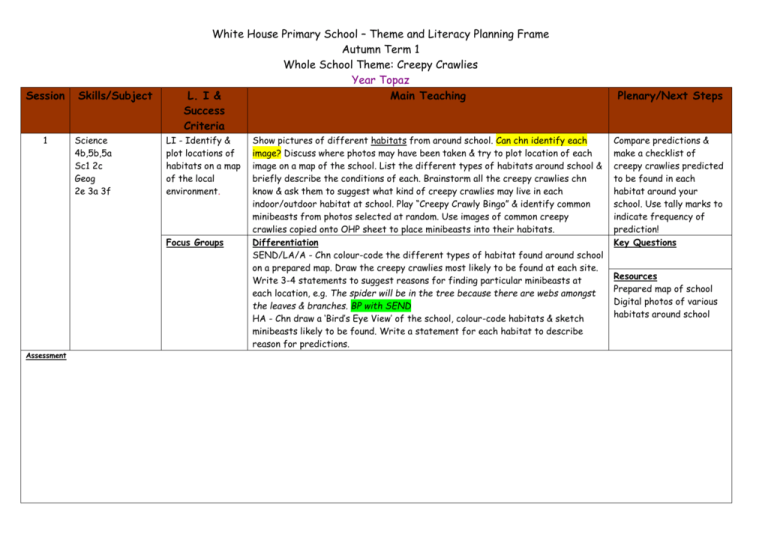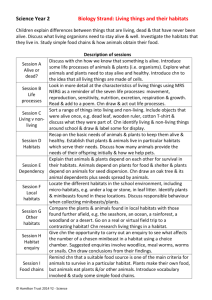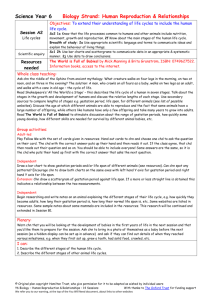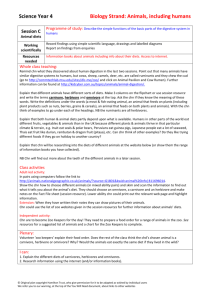Plenary/Next Steps - WhiteHouseCurriculum
advertisement

Session 1 Skills/Subject Science 4b,5b,5a Sc1 2c Geog 2e 3a 3f White House Primary School – Theme and Literacy Planning Frame Autumn Term 1 Whole School Theme: Creepy Crawlies Year Topaz L. I & Main Teaching Success Criteria LI - Identify & plot locations of habitats on a map of the local environment. Focus Groups Assessment Show pictures of different habitats from around school. Can chn identify each image? Discuss where photos may have been taken & try to plot location of each image on a map of the school. List the different types of habitats around school & briefly describe the conditions of each. Brainstorm all the creepy crawlies chn know & ask them to suggest what kind of creepy crawlies may live in each indoor/outdoor habitat at school. Play “Creepy Crawly Bingo” & identify common minibeasts from photos selected at random. Use images of common creepy crawlies copied onto OHP sheet to place minibeasts into their habitats. Differentiation SEND/LA/A - Chn colour-code the different types of habitat found around school on a prepared map. Draw the creepy crawlies most likely to be found at each site. Write 3-4 statements to suggest reasons for finding particular minibeasts at each location, e.g. The spider will be in the tree because there are webs amongst the leaves & branches. BP with SEND HA - Chn draw a ‘Bird’s Eye View’ of the school, colour-code habitats & sketch minibeasts likely to be found. Write a statement for each habitat to describe reason for predictions. Plenary/Next Steps Compare predictions & make a checklist of creepy crawlies predicted to be found in each habitat around your school. Use tally marks to indicate frequency of prediction! Key Questions Resources Prepared map of school Digital photos of various habitats around school Session 2 Skills/Subject Science 4b 5b 5c. Sc1 2f Geog: 2e 3a. 3f Assessment L. I & Success Criteria Main Teaching Plenary/Next Steps LI – explore habitats for signs of minibeasts Explain that we know that creepy crawlies live in various habitats around the school, but how can we collect samples for further study? Explore different ways of setting bug-traps, sunken plastic containers, fruit pieces on an open plate, lifting rocks, using nets, digging in topsoil, shaking branches & leaves over white paper, etc. Ask chn to suggest most suitable method for the collection of various insects, bugs, worms etc. List & collect equipment needed for the task & discuss qualities of a good observer or collector. Chn to look at the habitat location map created yesterday & discuss the different habitats they can explore. Review chn’s predictions for the type of creepy crawlies to be found in each habitat. Place specimens in suitable containers. Ask chn to check observations about the habitat in which the minibeasts were found & recreate the habitats. Focus Groups Differentiation Mixed ability Hand out a “Spotter’s Guide” to each pair & assign pairs to begin their search for creepy crawlies in different locations. Chn work with partner to explore 2-3 of the habitats found around the school. Pairs need to make & record observations about the habitat then search for & collect specimens. Chn record their findings on the “Spotter’s Guide”. Some minibeasts may not be immediately visible & suitable traps need to be made & set! Chn need to return to traps at a later time to clear & add information to “Spotter’s Guide”. Key Questions Resources Variety of resources to set traps. Spotters Guide x 20 Session 3 Skills/Subject Literacy: 1d 2a,b,c,d,e Science: 4b 5b 5c. Sc1 2j. L. I & Success Criteria Main Teaching Plenary/Next Steps LI – write a description of a perfect home for a minibeast. Highlight creepy crawlies found in habitats as predicted in S1 & add new species to lists. Are there any patterns to where chn found particular creatures? Look at maps created in S1 & consider the features/ conditions of each habitat. Compare chn’s description of the habitat on their “Spotter’s Guide” with the images used to introduce different habitats. Tell chn that they are to become estate agents whose mission is to sell habitats/homes to creepy crawlies! Look at online examples of home descriptions created by estate agents to sell property. Draw chn’s attention to persuasive language of the text e.g. “Delightfully situated’, “Great for entertaining”… What features would persuade minibeasts to move into a habitat? Select a habitat & demonstrate use of planning scaffold). Model writing of a description! Differentiation SEND - Chn select a habitat that they have studied & draw a sketch to show features. LA – as above but also - using writing scaffold chn record main points & plan their writing. They brainstorm & list persuasive adjectives & adverbs to use & then write a descriptive text to ‘sell’ an animal home. BP A - ind HA - Chn create plan to write a description for a Creepy Crawly home using computers. Chn role play different creepy crawlies as potential home buyers who meet the estate agent & describe their ideal home! The agents respond to requests by presenting & ‘selling’ the most suitable habitats in their current property portfolio! Focus Groups Assessment Key Questions Resources Session 4&5 Skills/Subject Science: 4b 5c. Sc1 2i 2j Art: 1a 2a L. I & Success Criteria LI – create a collage Focus Groups Assessment Main Teaching Ask chn to consider the information they have gained in their study of habitats. What are some of the conditions that alter from one habitat to another? e.g. light, water (dampness), soil, shade, temperature… State that animals are suited to the environment in which they are found. Collect information from “Creepy Crawly Safari” about minibeasts found in cool, damp places; shady dry places; under the soil; in tree foliage etc. Ask chn to consider what happens to a creepy crawly if its habitat is destroyed or if it is removed from the conditions in which it thrives. Some chn may have found examples of dead minibeasts e.g. insects on windowsills or in room corners. Compare & contrast two diverse habitats completing “Habitat Profile”. Chn work with a partner to make own detailed comparison of two habitats. Differentiation Mixed ability - Look at artwork in which collage has been used to represent a natural environment, eg. Jeannie Baker’s book, Window. Identify materials used in artworks. Allocate a habitat to each pair. Chn design a collage & collect a variety of materials from which to create their work e.g. textured materials, natural materials, clay, paper & cardboard. When collage is complete, chn construct & add small 3D models of creepy crawlies found in habitat. Plenary/Next Steps Bring collages together around the large-scale map of the school & link artwork to its location with arrows/ribbons. Ask chn to write & add a speech bubble (using long pins) explaining why the creature enjoys living in the habitat! Key Questions Resources Session 6 Skills/Subject Science: 1b 2d 2f. L. I & Success Criteria Main Teaching Plenary/Next Steps LI – plan a fair test Show chn a few woodlice & ask if they know what they are & whether they found any on their ‘Creepy Crawly Safari’? Use magnifiers to further investigate & describe the woodlouse – size, shape, colour, segments, how many legs, etc. Create a data chart to list facts about conditions woodlice prefer. Use online information to confirm findings. Tell chn that they are to plan a ‘fair test’ to investigate the question, “Do woodlice favour damp, dark habitats?” Talk about how chn might find an answer to the question & show them a plastic tray that has been split into 4 equal-sized areas i.e. dry & light/dry & dark/damp & light/damp & dark. Decide how many woodlice to monitor & how results should be recorded. Instruct chn on features of a procedural text to record task objective; materials required; steps to be taken & how results are to be recorded. Review steps for fair test. Label test trays & leave for agreed time period. Chn record movement of woodlice by counting numbers in each section & taking photos at regular intervals. Focus Groups Differentiation SEND - Chn consider ‘fair test’ procedure & use scaffold to record plan for the Key Questions investigation. They add labelled diagrams to support information in the text. Chn use online information & non-fiction books to research woodlice & write 2 interesting facts & illustrate – BP as a group LA – as a group – Science Diaries A – Pairs – Science Diaries HA – IND – Science Diaries Assessment Resources Science Diaries Session 7&8 Skills/Subject Science: 2f 2h 2j Maths: 2c 2f. L. I & Success Criteria LI – plan a fair test Focus Groups Assessment Main Teaching Plenary/Next Steps Chn need to have results of their fair test, recorded at regular intervals over a period of 2-3 days available for session. Discuss the data recorded by each group & compare with original expectations/predictions. Look at how data can be logged in a suitable program & converted to graphical representations. Demonstrate the use of data handling software (Microsoft Excel) & the different graphs (bar, column, pie, doughnut etc) that can be generated. Practise reading information presented in graphical form. What conclusions can be drawn? Write 2-3 statements about the preferred habitat of the woodlouse based on data collected. Differentiation SEND - Chn enter data into data handling program???? & generate graph. Write 2 statements about best home of the woodlouse. Create a colourful poster to summarise findings if time. LA – as above A – Chn use Excel to log results recorded over the period of the fair test. They generate 2 different graphical representations of the data & write 2 statements to explain findings. Also if time to create a Powerpoint slideshow to summarise their findings. Add photos & graphical information from test results. Together, describe the perfect house for a woodlouse! HA – as above Display posters & view Powerpoint slideshow. Restate what makes the perfect home for a woodlouse – living conditions, food source etc. Release woodlice into original habitat! Key Questions Resources Excel ICT Suite Session 6 Skills/Subject Science: 1b 2d 2f. L. I & Success Criteria Main Teaching Plenary/Next Steps LI – plan a fair test Show chn a few woodlice & ask if they know what they are & whether they found any on their ‘Creepy Crawly Safari’? Use magnifiers to further investigate & describe the woodlouse – size, shape, colour, segments, how many legs, etc. Create a data chart to list facts about conditions woodlice prefer. Use online information to confirm findings. Tell chn that they are to plan a ‘fair test’ to investigate the question, “Do woodlice favour damp, dark habitats?” Talk about how chn might find an answer to the question & show them a plastic tray that has been split into 4 equal-sized areas i.e. dry & light/dry & dark/damp & light/damp & dark. Decide how many woodlice to monitor & how results should be recorded. Instruct chn on features of a procedural text to record task objective; materials required; steps to be taken & how results are to be recorded. Review steps for fair test. Label test trays & leave for agreed time period. Chn record movement of woodlice by counting numbers in each section & taking photos at regular intervals. Focus Groups Differentiation SEND - Chn consider ‘fair test’ procedure & use scaffold to record plan for the Key Questions investigation. They add labelled diagrams to support information in the text. Chn use online information & non-fiction books to research woodlice & write 2 interesting facts & illustrate – BP as a group LA – as a group – Science Diaries A – Pairs – Science Diaries HA – IND – Science Diaries Assessment Resources Science Diaries Session Skills/Subject L. I & Success Criteria Main Teaching Plenary/Next Steps 1 Focus Groups Key Questions Differentiation Resources Assessment Session Skills/Subject L. I & Success Criteria Main Teaching Plenary/Next Steps 1 Focus Groups Key Questions Differentiation Resources Assessment Session 1 Skills/Subject L. I & Success Criteria Main Teaching Plenary/Next Steps Focus Groups Key Questions Differentiation Resources Assessment Session Skills/Subject L. I & Success Criteria Main Teaching Plenary/Next Steps 1 Focus Groups Key Questions Differentiation Resources Assessment Session Skills/Subject L. I & Main Teaching Plenary/Next Steps Success Criteria 1 Focus Groups Key Questions Differentiation Resources Assessment Session 1 Skills/Subject L. I & Success Criteria Main Teaching Plenary/Next Steps Focus Groups Key Questions Differentiation Resources Assessment Session Skills/Subject L. I & Success Criteria Main Teaching Plenary/Next Steps 1 Focus Groups Differentiation Key Questions Resources Assessment Session Skills/Subject L. I & Success Criteria Main Teaching Plenary/Next Steps 1 Focus Groups Key Questions Differentiation Resources Assessment Session Skills/Subject L. I & Success Criteria Main Teaching Plenary/Next Steps 1 Focus Groups Differentiation Key Questions Resources Assessment








